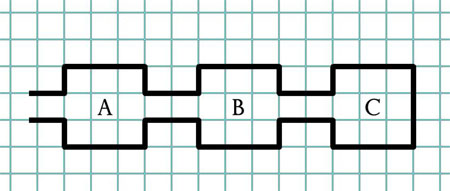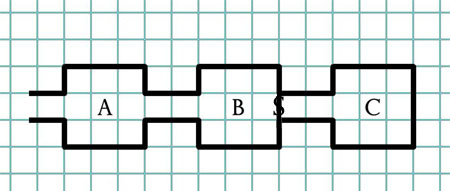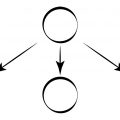Let’s turn our attention now to specifics: What are the exact navigation methods that can be used to guide characters into a node?
CLUES: Clues turn each node into a conclusion. When the PCs put the clues together, they’ll tell them where to go, who to look at, and/or what to do.
Clue-based scenarios are often considered fragile, but by using the Three Clue Rule and the Inverted Three Clue Rule you can make them robust.
One pitfall to watch for: In order to reach the next node, the PCs must know both what they’re looking for and how to find it. If you only give the PCs one clue telling them how to reach the Lost City of Shandrala, your scenario will remain fragile even if you include 20 clues telling them the Lost City of Shandrala is interesting and they should totally check it out.
On the other hand, clue-based node navigation conveniently organizes itself into mystery scenarios which provide over-arching push/pull motivations: Once the PCs are interested in unraveling the mystery, all you need to do is put a node on the bread crumb trails and they’ll follow it.
GEOGRAPHY: In other words, the choice of which way to go. The archetypal example is the dungeon, which generally provides a far more robust structure than a clue-based scenario. For example, consider this simple dungeon:

Moving from A to B to C requires no redundancy because the hallway provides a clear and unmistakable geographic connection.
However, geographical structure can occasionally create a sense of false security. For example, consider this very similar dungeon:

Now you have a potential problem: If the PCs fail to detect the secret door your adventure can easily go off the rails. (Assuming they need to reach C.)
Hexcrawls can be similarly problematic in that there’s no guarantee that any given piece of content will actually be encountered. (When I was 12 years old I remember pouring over a copy of X1 Isle of Dread and never quite figuring out how the PCs were supposed to “know where to go” in order to find all the keyed encounters.) Properly designed hexcrawls, however, employ a mode of redundancy similar to the Three Clue Rule: They don’t require you to encounter any particular piece of interesting content, but rather spread interesting content liberally so that you are almost certain to encounter at least one piece of interesting content even if you’re just exploring randomly. (This, of course, creates a high degree of extraneous prep. But hexcrawls are meant to be used over and over again, utilizing that extra content over the course of several passes.)
In geographical arrangements, obstacles serve as pushes. For example, if the PCs are in Room A and they want to get to Room C, then Room B is encountered only because it’s an obstacle. The PCs are pushed into encountering Room B because the geography of the dungeon requires it.
TEMPORALLY: The phone call that comes at 2 PM. The goblin attacks on the 18th. The festival that lasts for a fortnight.
Although lots of nodes can include time-sensitive components (“if the PCs arrive after the 14th, the Forzi crime family has cleared out the warehouse”), nodes that are triggered temporally are almost always a push: Something or someone comes looking for the PCs, pushing them into engaging with the node.
(Of course, temporal triggers can also be coincidental – like a red dragon attacking the Ghostly Minstrel when the PCs just happen to be dining there or the sun becoming eclipsed – but those are still pushes.)
Temporal triggers can also have some variability built into them. For example, you might decide that the Forzis hire a hitman to kill one of the PCs on the 16th. That doesn’t necessarily mean that the hitman will immediately find them.
RANDOMLY: Wandering monsters are the classic example of a randomly generated node, but they’re far from the only example. The early Dragonlance modules, for example, coded story events into their random encounter tables. Jeff Rients’ table for carousing mishaps offers a different set of possibilities.
Because of their long association with wandering monster checks, the random triggering of a node is often associated with the random generation of a node. Although both can be useful techniques, when we’re talking about navigating between nodes we’re primarily focusing on the random triggering of a node.
For example, in my current hexcrawl campaign the content of each hex has been fully keyed. But I use a set of mechanics to randomly determine whether or not that content is encountered by a group moving through the hex (i.e., triggering the node).
PROACTIVE NODES: A proactive node comes looking for the PCs. These are often triggered temporally or randomly, but this isn’t necessarily the case.
For example, instead of using random encounters I will often run small complexes in “real time” by splitting the enemy NPCs into small squads. I can then track the actual movement of each squad in response to the actions of the PCs.
One could also easily imagine an “Alert Track”: Every time the PCs do something risky or expose their activities in some way, the alertness level of their opponents rises. The rising alertness level could change the content of some nodes in addition to triggering a variety of proactive nodes.
In reading many published adventures, it’s not unusual for the first node to be entirely proactive. (The classic example being “an NPC wants to hire you for a job”.) But then many adventures will suddenly stop being proactive. Neither of these things need to be true.
It can also be tempting to think of proactive nodes as being a railroading technique. While they certainly can be used in that way, there’s no need for that to be true. Examples entirely free of predetermined GM machinations might include NPCs making counter-intelligence checks to discover the PCs’ identities or the PCs being tracked through the wilderness by enemy forces after they escape from the Dread Lord’s Castle.
In general, proactive nodes are useful for creating a living world in which there are both short-term and long-term reactions to the PCs’ choices.
FOLLOWING A TRAIL: I’m not sure if following a trail from node A to node B constitutes navigating by clue, geography, both, or neither, so I’m including it here as a common sort of special-case hybrid.
A trail, of course, doesn’t have to be limited to following tracks in the mud: Tracing data trails through the ‘net; hacking jumpgate logs; a high-speed car chase. There are lots of options.
PLAYER-INITIATED: In their quest to get from A to C, it’s not unusual for players to invent their own B’s without any particular prompting. Sometimes these can be anticipated (like most Gather Information checks, for example), but in many cases the players will find ways of tackling a problem that you never imagined (like the time my players inadvertently started a shipping company in order to find a missing person).
In the same spirit as permissive clue-finding, it’s almost always a good idea to follow the player’s lead: Your prep should be a safety net, not a straitjacket. (That doesn’t mean all their schemes should prove successful, but when in doubt play it as it lies.)














I’ve always tried to take this design methodology to heart. I’ve recently converted DEATH IN FREEPORT to fit 1920s Philadelphia and worked the mechanics to fit the (new) World of Darkness where the PCs are mortal investigators. I reworked the adventure into nodes instead of a linear progression. They’ve done a lot of stuff I hadn’t expected to but this allowed me to create new nodes on the fly with existing material. The adventure is taking longer to accomplish but is becoming a much more complex and interwoven tale.
Thank you so much for these blog posts. I’ve always preferred a more open, player-driven campaign style, and you’ve given me so much insight into how I can make that happen consistently. I’ve used some of these ideas, but this is so much more comprehensive than I’ve employed so far.
I think the Following a Trail section may really need to be explored more, or rather the various types of trails to be followed actually are different types of node connections depending on their type and origin. Tracking someone through the woods seems like clue-finding, while a car chase seems to be more like Proactive Node progression, alternating between pull and push dynamics as characters move through the chase.
I must say that the timeline effects are great but the players need to be aware of the time schedule upfront so that they can take an educated decission. Else only the GM knows what options they missed.
In my campaign I assigned a schedule for each of the 5 locations that they needed to visit. They could arrive at the scene when empty, with an initial encampment, fortification or abandonment.
I thought it was a great idea, but the players never knew that if they would have arrived earlier or later, the scene would have been different. They just took it for granted.
[…] this node requires the PCs to follow the thief’s trail from Tochigi to Wachimasu, and this is likely the first time the PCs will encounter a true […]